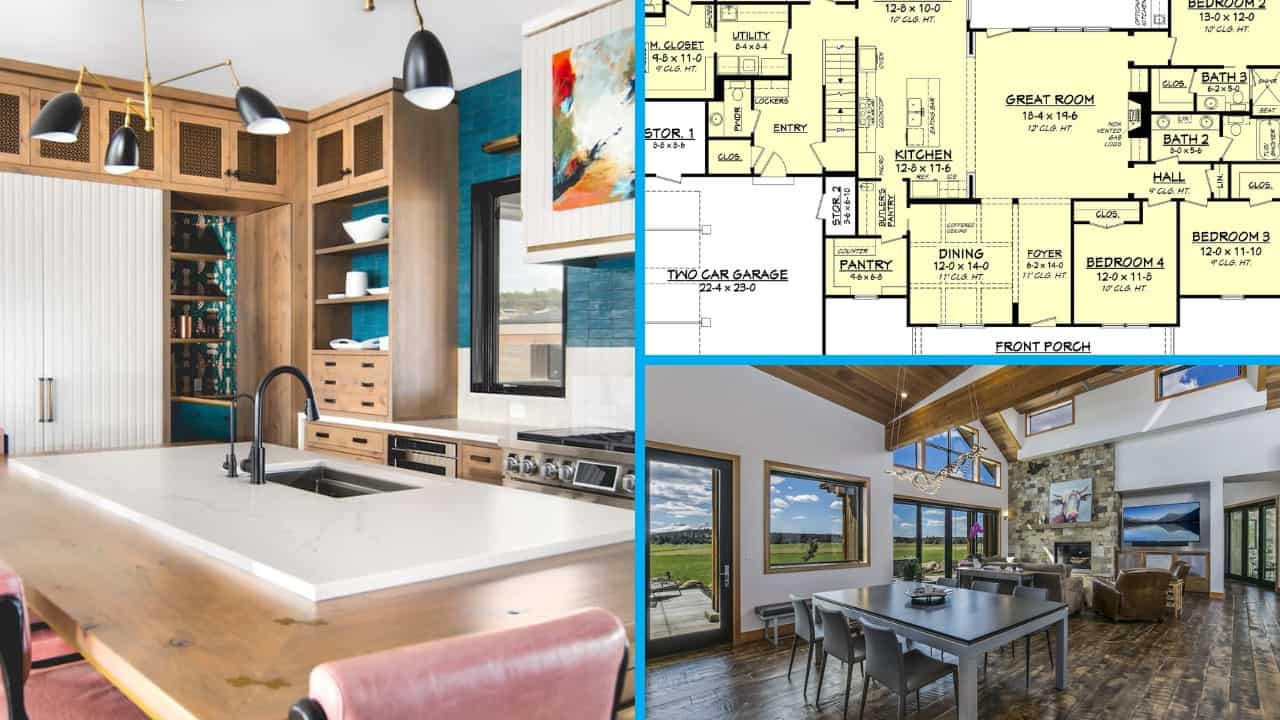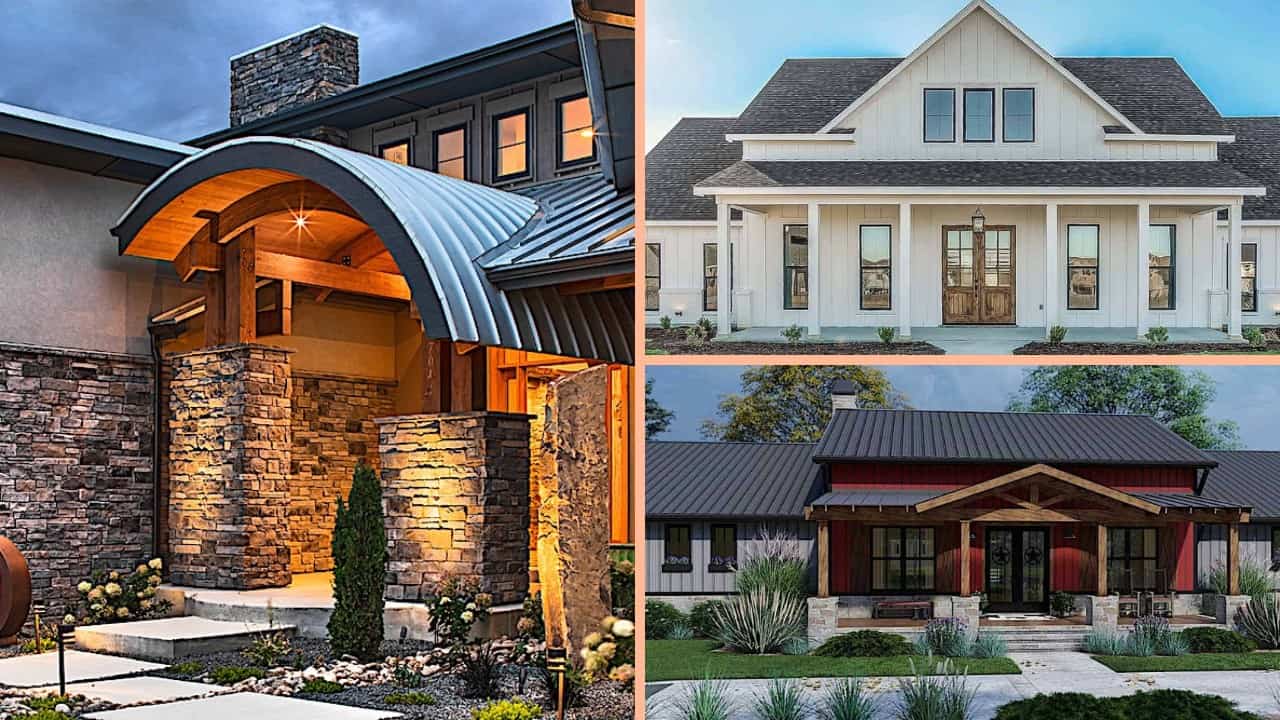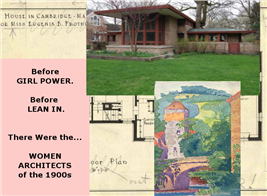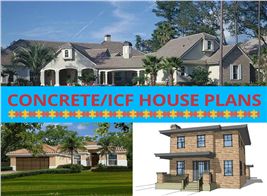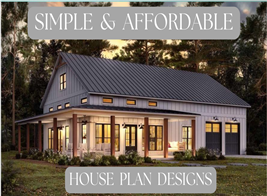Columns, Posts, Pillars, and Railings in Contemporary Homes
By Rexy Legaspi | Updated April 12, 2023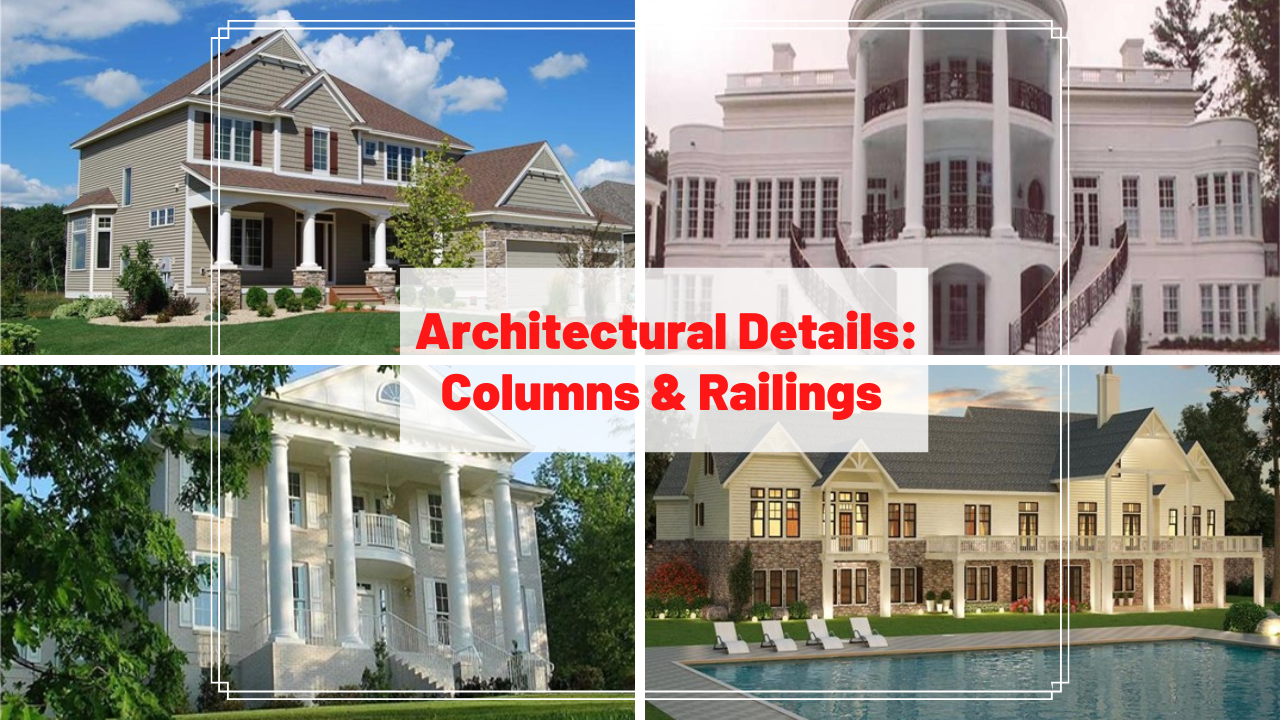
How Architectural Treatments Enhance Home Design
The house with the white round columns anchoring the porch is quite a distinctive sight on my block – a quiet neighborhood lined with one-and two-story brick homes, Ranch styles, and a lot of charming hip-roof Cottage homes with decorative shutters. While some more colorful homes are overlooked by those driving through, the house with the columns is always a conversation piece.
Why in the world are people fascinated by columns and pillars?
From the ancient Egyptian, Greek, Roman, and Asian civilizations to contemporary times, columns have been a vital part of the architectural aesthetic. Not only are they indispensable elements of the construction of a building – serving as structural support – but they also serve decorative purposes inside and outside the home.

This classic two-story, 4,378-square-foot Country home features a front porch with its roof supported by four tall columns, an elaborate doorway, and windows with shutters. The stunning home has an open floor plan design, four bedrooms, 4.5 baths, a rear porch, patio, study, den, game room, and other amenities (Plan #140-1008).
Let’s take a close look at the different classic column types, their components, materials, the best shapes and sizes for your home, practical and structural uses, and their decorative functions.
Column Details and Components
The ancient Greek and Roman columns had basic features called capital, shaft, and base. Here are more details on the components of a column.

- The Base or lowest part of the structure - From the amazingly simple to the ornate, column bases depend on style and history. For example, Doric columns have no base, but Ionic ones have decorative moldings and thin bands. In other designs – like columns found on Craftsman homes – the bases are mounted on a pedestal.
- The Shaft is the long part between the base and the top portion (capital). Of the Greek columns, Doric shafts are the biggest in diameter while Ionic and Corinthian shafts are slimmer and fluted. The Roman-influenced Tuscan shafts are smooth, simple, and unadorned.
- The Capital covers all the upper features of a column and includes:
- Necking, which is directly below the top part, is a continuation of the shaft with one or more narrow grooves.
- Echinus– located between the necking and abacus – this is a circular figure with decorative molding
- Abacus is a supportive square slab atop the capital to add extra support for the column

A sketch of an Ionic column shows the details of the top part of the column – or the capital. The abacus – the square slab directly under the capital – provides additional support. The echinus – between the necking and abacus – is circular with decorative molding (source: The Ancient Greek Architecture).
Architectural Styles and Their Columns
Classic architectural columns from ancient Greece, Rome, and Egypt appear in Colonial, Cottage, Southern Plantation, Georgian, Farmhouse, and Rustic style homes. Their simplified versions were popularized during the Arts and Crafts movement as well as during the development of Midcentury Modern Design.
The Craftsman Column with its simple, tapered, and square-shaped design is highlighted in Arts and Crafts style-inspired homes, in Bungalows, and of course, in Craftsman homes,
One-Story Colonial
Simple, classic, and tall columns define the covered front porch of this one-story, three-bedroom Colonial home. Stretching across – and defining – the front porch, the columns also frame the wood and glass door (Plan #109-1184).
One-Story Craftsman
1.5-Story French Country Plan
Modern One-Story Farmhouse
Plantation-Style Southern Plan
Symmetry and balance reign supreme in this two-story classic plantation-style Southern home with the gorgeous covered front porch. Simple and elegant columns stand tall and large multi-pane windows allow abundant natural light to filter the interior. Adding to the stunning exterior are hip-style rooflines with window dormers. The 3,338-square-foot home includes four bedrooms, 3.5 baths, main floor master, laundry, morning room, and family room (Plan #180-1018).
Architectural Column Material Options
The common materials used for columns includethe following:
1. Aluminum may be lightweight but is strong enough to bear loads of up to 43,000 pounds. It is affordable, maintenance-free, made for easy "snap-together" installation, and available in a variety of factory-applied faint finishes.
2. Fiberglass is manufactured to achieve specific mechanical and aesthetic qualities. The composite material is strong without additional bulk .
3. PVC, like aluminum is easy to install, durable and a budget-friendly choice for decorative porch columns. This material is moisture, pest, and rot resistant - and available in many contours.
4. Wood is for the purist who wants to maintain the historical integrity of the home. Poplar or pine are popular choices and can be painted and stained to achieve the classic look.
5. Polymer Stone is a synthetic stone column molded to simulate traditional stone porch posts – with half the weight of real stone but without the unwieldy installation procedures. Load bearing and manufactured in classic stone finishes, polymer is often used in restoration of homes to their original architecture or to add classic decorative accents to contemporary styles.
Design Details: Interior and Exterior Columns
How about design details, size of columns, styles, and preferences?
Aside from functional purposes. you can add columns and posts to your home and tailor them to the architectural style, layout, and your design preference. For example, exterior columns provide structural support and replacements for deteriorating front posts as well as an amazing visual effect to the homes front facade. People who want to create or enhance curb appeal are going for attractive exterior columns for a "wow" factor at first sight.
Balance and proportion equal a stunning exterior for this 2,232-square-foot Country Ranch style home. The four-bedroom, 2.5-bath home features a landscaped front yard, a beautiful covered front porch anchored by six wood columns, and a hip roof with dormer windows (Plan # 206-1034).
The Right Column Size
Choosing the appropriate column size depends on how much weight the structural columns are going to support. This includes a porch overhang or part of the roofing system. You may need a structural engineer to calculate the load bearing requirements, spaces between posts, and ensure the base rests on a solid and level foundation.
The structural columns are generally available in heights from 7 to 10 diameters of the column to fit a wide range of installations. For decorative columns, think of the homes front entrance square footage and style to determine the size of the columns.
The Right Column Style for Your Home
There are several column styles to consider for the home. When choosing column styles, think of the architectural style and overall effect of your choice on the home’s appearance.
Squared vs. Rounded
Often seen on Arts and Crafts styles – bungalows, Craftsman, Dutch Colonial – square columns are versatile and the conventional choice for contemporary homes.
The classic design of rounded columns is an ideal fit for homes in the Neoclassical and Victorian styles.
This spectacular two-story Coastal style home with Contemporary Colonial characteristics is quite a sight to behold. Instead of the rounded columns typical of most Colonial homes, the 5,653-square-foot home features square columns on both the front porch and balcony. The home has five bedrooms, five bathrooms, and two powder rooms (Plan #175-1243).

A fabulous two-story, 3,270-square-foot home, with the traditional huge, rounded columns of the Colonial style, is a definite showstopper. Beyond the magnificently imposing white columns on the covered porch, is a comfortable and warm interior that includes four bedrooms, dining and living rooms, three bathrooms, and a powder room, game area, and Juliet balcony (Plan #178-1034).
Tapered vs. Non-tapered
Tapered columns give a taller and streamlined look on classical columns, and non-tapered columns achieve a simple and subtle look.

This majestic Colonial style home inspired by the White House features fabulous slightly tapered round columns in tis rear view that soar up two floors to the upper veranda. The 8,210-square-foot luxury home has six bedrooms, six bathrooms, three powder rooms, an amazing spiral staircase, a grand room with a fireplace, and a master suite with a sitting room, walk-in closet, and master bath (Plan #106-1206).
Fluted vs. Non-Fluted
With the fluted column, you get a series of vertical grooves that run the entire length of the column as added decorative touches. The non-fluted has an unadorned smooth and clean shaft.
This entry way of a stately two-story, 5,730-square-foot European-inspired manor features tall, fluted Corintian columns that add to the grandeur of the front door. The luxurious home has three bedrooms, four baths, two half-baths, breathtaking spiral staircase, Grand Room with fireplace, main floor master suite, family room, and in-law suite (Plan #106-1154).
Load bearing vs. Decorative
A load-bearing column is a structural element that supports the roof and the porch. It needs the appropriate column material that can withstand the weight of the building or home. Decorative columns are for adornment purposes, and do not support the weight of a porch roof, overhang, or ceiling.
Adjustable vs. Non-adjustable
Adjustable columns work well if you want different heights along the front porch. For this, experts recommend fluted, single-piece PVC columns. If you want the same height, non-adjustable columns are the appropriate option.
Columns Inside the Home
While exterior columns support the porch and roof overhang, interior columns bear the load of the upper floors of the building or home. They are also installed as decorative accents to add charm, elegance, and style to the interior.
1. Create a dramatic look to the main entryway
2. Provide a separation zone between living areas in an open floor plan
3. Add a luxurious accent to a master suite, master bath, or spacious kitchen
4. Impressive structural support in the rear outdoor living/entertainment space
A dream of a rear deck everyone has to love! The beautifully landscaped space, attractrive columns that support the verandas on the upper floor, and pool are some of the amazing features of this two-story Transitional Craftsman/Cape Cod home. The residence has 2,830 living square feet, three bedrooms, 2.5 baths, and a vaulted Great Room, chef’s kitchen, and mudroom (Plan #106-1315).
Classical Column Types
From the primitive pillars of the Stonehenge, one of the world’s most famous prehistoric monuments, to the carved stone columns that supported and adorned the pyramids in Egypt to the classical architectural style in ancient Greece and Rome, column design has been around for centuries. Its emphasis on symmetry, proportion, and repetition is still evident today in architectural features of modern buildings and homes.

Columns are often used for structural and decorative purposes on porches, and they come in different shapes, sizes, and styles. Most columns trace their origins from the ancient Greeks and Romans who gave the world the Classical Orders of Architecture. The Greeks gave us the Doric, Ionic, and Corinthian columns while the Romans introduced the Tuscan and Composite designs.
1. The Doric Column is the simplest of the Greek columns, with a plain round top part or capital and a fluted shaft (the long part). One of the most iconic examples of buildings with Doric style columns is the Lincoln Memorial.

2. The Ionic Column is the thinnest of the five classic columns and is more ornate than the Doric style. It has slender shafts that can be fluted or not, a large base and scroll-shaped ornaments on its top part. The Jefferson Memorial, the U.S. Capitol Building, and the Supreme Court Building all feature Ionic columns.

3. The Corinthian Column is more elaborate than the Ionic and Doric designs. The most decorative of the Greek columns, the Corinthian has a slender fluted shaft and a top part with detailed carvings of leaves, flowers, and small scrolls. The New York Stock Exchange Building and the Metropolitan Museum of Art in New York are outstanding exhibits of the design.

4. The Tuscan Column, which originated in ancient Italy, is much like the Greek Doric column with its plain capital and base. Unlike the Doric design, the Tuscan column has a slimmer and smooth, unfluted shaft. It is often seen in Neoclassical style buildings, plantation homes, and Antebellum mansions.

5. The Composite Column is a mix of the Ionic and Corinthian designs – combining the scrolls from the Ionic and the leaves of the Corinthian columns for its composite look. Famous buildings that feature Composite Columns include the Arch of Constantine and the Pantheon in Rome.

The Paris Pantheon – located in the 5th arrondissement on the Montagne Sainte-Genevieve - was originally a Church dedicated to Saint Genevieve. Its exterior columns were inspired by the Roman Pantheon commissioned by Marcus Agrippa (image credit: Public Domain).
Related Architectural Details
Railings and Posts
Another architectural detail that can be both functional and decorative is the railing. An important feature of stair safety, railings can have guardrails, handrails, posts, balusters, and one or more bottom rails. They are installed to provide stability, balance, and support as people walk up and down the stair steps.
While safety first may define this architectural element, the railing gives stairs a visual presence that is interesting and eye-catching. They come in a variety of shapes and designs – there are U-shaped and spirals that can be attached to one of both sides of a stair or wrapped around a landing.

The components of a stairway railing are shown in this illustration (source: Autodesk).
If you want to create a dramatic effect with your stair railings, just look at this spectacular staircase in a two-story, three-bedroom, 5,730-square-foot European style home. It is truly Scarlett O’Hara-worthy. Look at the elaborate details on the balusters and the handrail (Plan #106-1154).
Column or Post?
Whats the difference?
Posts are narrower than columns and look more like wood structures rather than stone. Like columns, posts are architectural elements that enhance the appearance and aesthetic of a home. In most cases, posts are used when columns may overpower the homes architectural design or are just not appropriate.
Simple timber posts are ideal for rustic homes, cabins, and some vacation homes. Even Victorian homes can use intricately detailed porch posts to match their balusters.
Eye-catching pairs of narrow timber posts on stone pedestals anchor the spacious wrap-around porch of this 1.5-story Farmhouse style home. The 1,805-square-foot home with two bedrooms and two bathrooms features a luxurious master suite, mud/laundry room, U-shaped kitchen, upstairs bonus room, and four-car garage (Plan #193-1181).
Why Make Columns a Part of Your Home Design?
Function and style. How can you argue with that when it comes to the structural integrity and aesthetic of a home?
Columns, posts, and railings are architectural details that can add elegance and visual power to a homes exterior and interior. Think of the impressive and attractive sight of a colonnaded portico, porch, or veranda. Or a column as a statement piece inside the home.
As these elements find their way into contemporary architecture – whether office complexes or residences – builders and designers are making columns, posts, and railings part of the spaces they design. Not only are they crucial to the construction of a home, but they also enhance curb appeal and give that dash of impeccable style and charm to the interiors.
Whether you love the classic column styles or the modern look of the 21st century creations, think of columns as unique design elements that can transform your home’s facade into a work of art.
Footnote: The top left photo in the lead image of this article is a four-bedroom, 2,697-square-foot Country home with four stunning columns on stone supports. For more details on this lovely home with a spacious Great Room and four-season porch, go to: Plan #146-1496.














